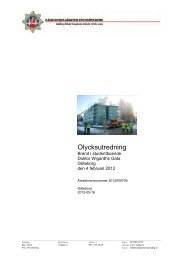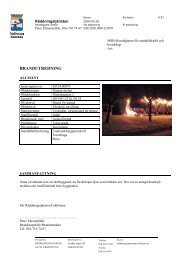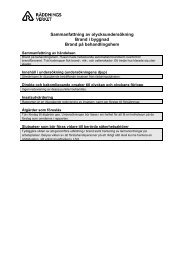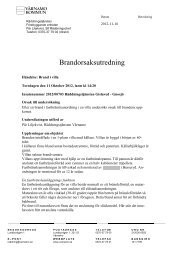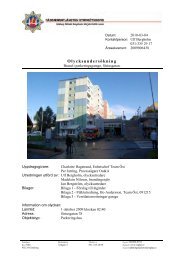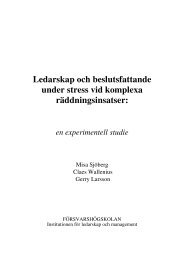Ministermordet - RIB Bibliotek
Ministermordet - RIB Bibliotek
Ministermordet - RIB Bibliotek
Create successful ePaper yourself
Turn your PDF publications into a flip-book with our unique Google optimized e-Paper software.
case this symbolic action took on an<br />
even deeper nature due to the actors'<br />
personal closeness to the victim and her<br />
family.<br />
Crisis management<br />
at central level<br />
At departmental level the crisis was<br />
handled with satisfactory routine sensitivity<br />
derived from past experience of<br />
several serious emergency situations<br />
over a number of years. Crisis management<br />
could be quickly commenced at<br />
the three most closely affected departments<br />
(the Cabinet Office, the Foreign<br />
Office and the Department of Justice),<br />
facilitated by the fact that most players<br />
were on hand apart from the prime<br />
minister initially. Crisis managers gathered<br />
at short notice albeit meeting informally<br />
at the Foreign Office at first.<br />
In this department they realised the<br />
double dimension immediately, whereupon<br />
crisis management was mobilised in<br />
parallel with external action (see below).<br />
The special circumstances combining<br />
the political nature of the event<br />
with the emotional proximity to it presented<br />
many actors in authority with<br />
special circumstances for crisis management<br />
and communication. The practical<br />
experience garnered from earlier crisis<br />
events necessitated a certain urgent<br />
need for adjustment and improvisation.<br />
This is "natural" per se since no crisis<br />
event is like another and every event<br />
requires its own specific practical mode<br />
of action.<br />
The speed with which crisis management<br />
and communication were established<br />
can be put down to the fact<br />
that the central players in this drama<br />
received information about the event<br />
straight from the scene of the crime,<br />
and to the fact that the media appeared<br />
at very short notice to confirm the fact<br />
of the occurrence. The first editors<br />
were ringing up just ten minutes after<br />
the stabbing, before the Department<br />
had been told (apart from a few people).<br />
This is a clear sign of the intensified<br />
and compressed communication processes<br />
taking place in today's society.<br />
Crisis management was carried out<br />
in Parliament too in connection with<br />
the murder of Anna Lindh. A group<br />
meeting was held principally for staff<br />
when her death was made known and<br />
a memorial service when Parliament<br />
resumed work in the autumn.<br />
Crisis communication<br />
and media contacts<br />
Crisis communication after the current<br />
outrage took on other forms than in<br />
earlier events. Press information and<br />
the media contacts thus came about, as<br />
far as government level is concerned,<br />
amidst an environment of crisis and<br />
mourning and took on a more immediate<br />
form with the provision of directly<br />
arranged information. Those responsible<br />
for this information - not least the<br />
prime minister himself - were deeply<br />
affected personally, but many journalists<br />
were also deeply emotionally affected at<br />
english summary | 125





